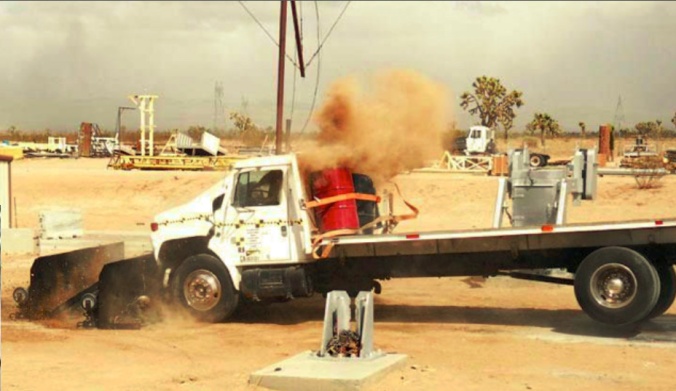Hostile vehicle mitigation is the term used by Government agencies and the security industry to ensure the safety of large crowds and pedestrian masses. Melbourne has endured 3 such incidents in the last two years with fatalities occurring on two occasions. It is important to understand that the perpetrators in all three incidents were deemed mentally unstable. These were not terrorist inspired actions, although such tragedies as the Nice and Berlin Truck rampages no doubt encourage a range of ‘me too’ lunacy.

AML Risk Management is at the forefront in the provision of portable, effective crash barriers to provide Hostile Vehicle Mitigation in public places, as was recently noted in Melbourne’s Herald Sun Newspaper
Tougher barriers for March
Super-strength steel barriers will be installed to shield crowds at Anzac Day marches this year to prevent deadly attacks and rampages.
The barriers – which are so strong they meet the standards of the US defence force and Homeland Security – are already being used at the South Melbourne Market. It is the first time the technology has been used in Australia.
The three Archer 1200 barriers are designed to protect high traffic and pedestrian areas from dangerous and threatening vehicles and can stop a vehicle travelling at 50km/h. They can also be used in the event of changing threat levels.
AML Risk Management will install the barriers at Anzac Day marches and other major events in Melbourne this year.
Managing Director Andrew Duffy said the company has several bookings in 2018.
“We plan to continue implementing vehicle mitigation strategies, and increasing the safety and security of events in Melbourne” he said.
“The feedback we have received has been excellent. Comments were made by members of the public claiming they were pleased to see action being taken against hostile vehicles.”
South Melbourne Market manager Ian Sumpter said the barriers were among key safety measures that form part of the market’s risk management strategy.
Source: Herald Sun

For further information and recommendations from the Federal Government’s National Security operation, please read section 2 here of its media release on the subject.
How to separate hostile traffic from pedestrians –
Hot spots such as outdoor markets, parades, festivals and sporting events In designing and applying measures to mitigate hostile vehicle risks in public spaces, it is important
to consider equally the needs of the normal users of the space. Spaces must be safe but they must also be functional, such that the level of security is proportionate to the level of risk.As such, a ‘one size fits all’ approach is not effective: mitigation solutions must be tailored to the physical and practical context. Additionally, since threat levels and terrorist methods evolve over time (often in response to security methods), both current and future security needs must be taken into account and security measures reviewed periodically for effectiveness.
For most existing locations and in some new build designs, there are issues that should be considered to maximise both the functionality of the space and effectiveness of the HVM measures, such as:
- Business needs (e.g. budget, health and safety);
- Logistics (e.g. traffic management, operational requirements);
- Pedestrian and traffic throughput;
- Disability legislation; and
- Building (e.g. appearance, planning consent)
In this case a risk management plan, including a vulnerability assessment, should be conducted to understand what impact the functional needs of the space has on the proposed HVM measures.
Crowded places – Outdoor special events
It is important to take a holistic approach to the security of an outdoor special event where large crowds are expected. Your initial assessment must consider all foreseeable threats which should inform your decision in selecting an appropriate venue.
For vehicle risks, and where possible, it’s considered good business practice to select a venue that contains existing natural barriers, e.g. large bolders, well established dense trees lines, natural berms, ditches, running rivers or creeks. This will reduce the amount and ultimately the cost of hiring re-deployable vehicle barriers.
Remember to consider other risks when installing security measures so not to introduce vulnerabilities to other risks.
Safe places by design
The strategic integration of steps, columns and sculptures into the building’s design offers a good example of how hostile vehicle mitigation can be applied in a subtle way. A flight of steps leading into a building can restrict access to most conventional vehicles, presenting the building as a less desirable target.
Strategically placed mitigation devices such as spheres, planter boxes, seats, or bollards on the pavement surrounding the entrance of the building provides additional protection against unauthorised vehicle intrusion while increasing the standoff distance. It is important to ensure that barrier solutions that may not be purpose built (e.g. planter boxes, sculptures) are properly mounted and reinforced against impact. This may require advice from a qualified engineer with experience in HVM.
To be continued next week
Source: nationalsecurity.gov.au
AML provide planning, prevention and protection with the exclusive use of the Meridian Crash Barrier systems. Deployed, the systems will stop a vehicle travelling at 50km/h completely.

AML – real security, real protection, through planning and prevention.












